Course:GEOS303/2023/Sri Lanka
Sri Lanka is an island nation in the Indian Ocean, exuding a magnetic charm with its rich history, vibrant culture, and diverse landscapes. Home to over 21 million people, its bustling capital, Colombo is a hub of activity. Situated between 6 and 10 degrees North, Sri Lanka experiences a tropical monsoon climate, marked by perpetual warmth, humidity, and distinct wet and dry seasons.[1]
Sri Lanka's diverse ecosystems are shaped by a dynamic interplay of monsoons, conventional processes, and synoptic-scale weather systems from the Bay of Bengal. [1] This intricate balance sustains a range of environments, including lush rainforests and arid plains.[2] The island's rich natural heritage flourishes in this harmonious beland, showcasing a diverse array of biodiversity [2]. Explorers are invited to witness the captivation history and nature in this thriving ecosystem.
Climate and biomes
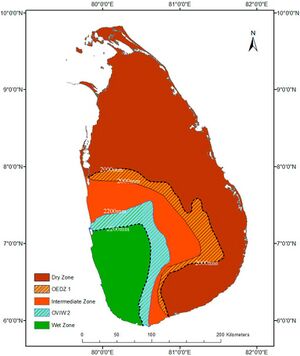
Sri Lanka is profoundly known for their diverse biomes and ecoregions. Sri Lanka is home to a wide range of natural ecosystems which include lowland rainforests, tropical montane forests, dry-mixed evergreen forests, grasslands, and mangroves. [4]
- Lowland Rainforests
- The Lowland Rainforests in Sri Lanka are primarily located within the Southwest and South-Central Regions[5]. These areas are crucial for the rich biodiversity on the island which contribute to the ecosystem services including climate regulation and nutrient cycling which are crucial aspects of the biogegraphy on the island.[5] These rainforest areas are home to over 94% of endemic angiosperms as well vertebrates and invertebrates that are unique to the island.[5] This ecosystem is threatened by habitat degradation which highlights the importance of conservation projects in efforts of protecting these areas.[4]
- Tropical Montane Forests
- The tropical Montane Forests in Sri Lanka are crucial aspects of the wet montane forests that are located in the South West and South-Central Regions of the Island. [5]These forests are key habitats for promoting biodiversity, though they cover only a small area the wet zones are critical for preserving the unique biodiversity and highlighting the importance of montane ecosystems in Sri Lanka's ecological landscape.[4]
- Dry-mixed Evergreen Forests
- This region has a strong emphasis on bidoiversity in this area throguh supporting Asia's largest elephant population pertaining over 6000 elephants [6]. Elephants are herbivores, which makes this ecoregion so crucial as it provides the species with large quantities of grassses, shriubs and trees which are a large part of their diet as well the large trees provide shelter and habitat for the species.[6]
- Mangroves
- Through providing biodiversity hotspots, coastal protection, and carbon sequestration Mangroves are essential biomes in Sri Lanka. [5]As these areas face threats including deforestation, pollution, and aquaculture expansion it is crucial that conservation efforts are in place to protext these areas and continue supporting the island.[2]
- Sri Lanka exhibits a diverse climate characteried by threee main regions; the Wet Zone, Dry Zone, and Intermediate Zone.
Sri Lanka exhibits a diverse climate charactierzied by three main regions; the Wet Zone, Dry Zone, and Intermediate Zone. The wet zone covers the Southwestern and Central highlands. This area experiences a substantial mean average rainfall annually averaging at 2500 mm with singificant dry periods throughout the year.[7] The dry zone primarily pertains in the Northern and Eastern regions where they receive an annual mean rainfall of less than 1750 mm annually with distinct dry seasons from May to September. [7]The Intermediate Zone contains the Central Highlights areas excluding Southern and Western regions experiences a mean annual rainflal fof 1750 to 2500 mm charactierzied by shorter less prominent dry seasons. [7]The geography and ecology in Sri Lanka is significantly impacted by the climatic diversity across the varying ecosystem and habitats in this area.
Diversity
Sri Lanka comprises of a very diverse ecosystem, with varying grasslands, forests and maritime ecosystems. The marine fishery in the Indian Ocean, which surrounds Sri Lanka, is dependent on a variety of food and shellfish, including lobsters, as well as predatory species like reef sharks[8]. Additionally, there are roughly 38 species of marine mammals, including over 20 species of dolphins, one regionally extinct dugong species, and 37 cetacean species, including the sperm whale and blue whale[8]. The salt marshes are dominated by the ecosystem-specific halophytic or salt-loving plants Sueda maritima, Salicornia brachiata, Halosarcia indicum, and S. monoica[8]. Waterfowl and milkfish can also find habitat in these marshes.
Plant families, Rhizophoraceae, Acanthaceae, and Avicenniaceae, as well as the tree species Rhizophora apiculata, Rhizophora mucronata, Ceriops tagel, Bruguiera gymnorhiza, Acanthus illicifolius, Lumnitzera racemosa, Avicennia officinalis, and Avicennia marina, dominate the mangrove ecosystem. [8]There are 18 distinct real mangrove species that have been identified in Sri Lanka. These species are all able to flourish in salty environments with changing water tables.[8]
The environment of inland forests range from rainforests in the wet zone to thorny scrub in the arid zone. Forests can be found in the seasonally dry and middle zones between these extremes. There are 15 distinct floristic regions on the island, which have been identified based on the patterns of distribution of the angiosperm flora and their endemicity.
Up to 60 to 75 percent of the tree species in these woods are indigenous.
The ecotone, or transition between forests in aseasonal and seasonal climates, is represented by tropical moist evergreen forests, which are 25–30 m tall. Both the tropical lowland wet evergreen forests and the tropical dry mixed evergreen forests, as well as some of their own species, share commonalities in their species makeup. Tropical dry mixed evergreen forests make up 16% of the island's total land area and 54% of the island's natural forest cover.[8]
There are 247 species of land snails from Sri Lanka, out of which 83% are known to be endemic to the region.[9]
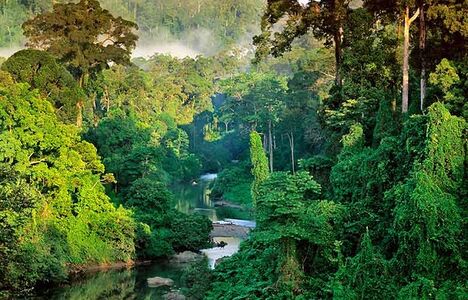
Human influences
Human Influence on Ecosystems
Sri Lankan people have always put great value into the protection of forests and animals on their island as biodiversity conservation was ingrained into their religious and cultural beliefs. [10] In ancient Sri Lanka, forests were owned by kings and certain forests were designated as protected areas where humans couldn't enter which shows early examples of fortress conservation in Sri Lanka. [10] Additionally, buddhism has always given Sri Lankan's spiritual motivation to preserve the natural environment and biodiversity.
When the colonial era began in Sri Lanka, there was large scale deforestation to make room for more urban and agricultural development. [10] As the population has begun to sky rocket in Sri Lanka, many more forests are being cut down to make room for more agricultural land to feed the growing population. [10] At the same time though, even though biodiversity on these agricultural lands is not as high as the natural ecosystems, many plantations and agricultural areas still contribute to biodiversity and conservation of certain species. [10] Agricultural ecosystems in Sri Lanka are becoming a whole other source of biodiversity other than forest, wetland and coastal ecosystems. [10]
Sri Lankans have a deep relationship with the natural world, especially its forests, and have used them for a variety of purposes. Although the degree of the local population's economic reliance on rain forest resources varies, roughly 8% of households may be wholly dependent on them.The people of a small village called Sinharaja utilize chena (slash and burn) farming to supplement the yield of their home gardens. Typically, they harvest their crops in December and use fire to help remove the foliage in early to mid-March. But generally speaking, not everyone has a reliable source of income.[11]
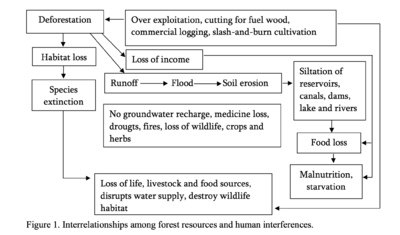
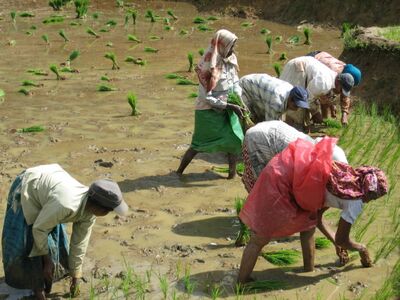
Observed Impacts on Biodiversity
"Industrial and agricultural development, as well as urbanization, have led to substantial land-use transformations across Sri Lanka’s major river basins, damaging hydrological variability, habitat structure, and water quality."[12] Even though Sri Lankans have a deep connection with nature, the plague of development still negatively impacts the environment of Sri Lanka. The natural forest covered 44% of the country in 1956, this dropped to 27% by 1980 and during the last decade 1.5% of that was further lost due to land conversion. Total forest cover in Sri Lanka remains at about 25% of its land area.[9]
Conservation
Muthurajawela Marsh - An Urban Protected Area
The Muthurajawela Marsh is a very important wetland located on the western coast of Sri Lanka that has preserved it's natural state despite being near an abundance of human activity. [13] To ensure it's biodiversity was preserved despite being in a very urbanized area, a conservation management plan for the marsh was created in consultation with local communities to ensure sustainable resource use from the marsh. [13] The marsh is not a strict protected area though and still is home to a population of about 4000 people who live on low income. [13] Additionally, it has been shown that an unsustainable use of resources in the marsh by local people has been linked to their poverty and unemployment so the conservation project is focusing on improving their living conditions and income. [13] The local people are also playing a key role in the management of the urban protected area by providing their traditional knowledge of the ecosystem and species within it. [13]
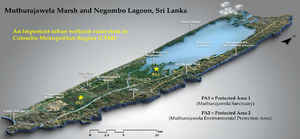
The Muthurajawela marsh is a great example of how conservation projects that create non strict protected areas within urban areas using traditional and local knowledge are more effective than strict protected areas at promoting sustainable resource use and economic gain for local people at the same time. A minimum of 129 plant species have been found in the marsh recently which shows the high biodiversity of the area and also about 280 local families have received permanent housing in the area which shows the combined biodiversity and economic success of the protected area. [13]
Mahaweli River Basin Development
A noteworthy conservation project in Sri Lanka is the Mahaweli River Basin Development Project. The project's rationale stems from the urgent need for balance between economic development whilst prioritizing environmental conservation. The Mahaweli River Basin is vital for agriculture, providing water for irrigation but also a home to diverse ecosystems and biodiversity.[15] The project aims to find a harmonious balance between meeting human needs and protecting the region's ecological integrity. In efforts to employ the implementation of the sustainable land and water management practices, the project focuses on reforestation, soil conservation and the establishment of protected areas.[15]Incorporating community based approaches and engaging local residents in conservation efforts is crucial in promoting sustainable agriculture and mitigating human-wildlife conflicts, the project seeks to foster environmental resilience. The project poses to be a successful project in both regards to conservation and socially. These initiatives to rehabilitate the degraded ecosystems and safeguard crucial habitats have resulted in a noticeable rise in biodiversity. Through involving local communities and empowering residents this project has shown to enhance their livelihoods and impact the community.[12] As the project continues to evolve, it is crucial to incorporate aspects of assessing potential conflicts that may arise between conservation goals and community needs, however ongoing efforts are crucial in addressing these challenges and furthering the efficacy.[15] This project poses a testament to Sri Lanka's commitment to sustainable development and the preservation of natural heritages.
Sinharaja Conservation Project[16]
The Sinharaja group of forests once covered an area of around 100,000 hectares, of which 47–48% still exist today.
When it became a part of the UNESCOs Man and the Biosphere (MAB) program, it was included to the global network of biosphere reserves in 1978. This reserve and its northern extension were designated as Sri Lanka's first National Wilderness Heritage Areas in October 1988. The Sinharaja Biosphere Reserve was the first natural site in Sri Lanka to be inducted into the World Heritage List by UNESCO in December 1988.[16]
Sinharaja conservation is prioritized in Sri Lanka's forestry sector planning and is based on tactics taken from contemporary protected-area management theories. In order to establish a plantation economy, the British cleared wet zone forests in the 19th century and planted products like coconut, rubber, coffee, and tea. They also constructed a network of roads and railroads to support this growth. Consequently, by the 1850s, the wet zone's rain forests had already begun to fracture. In order to oversee national parks and reserves where logging was forbidden and carry out the provisions of the Fauna and Flora Protection Ordinance, a new Department of Wildlife—now known as the Department of Wildlife Conservation—was founded in 1949. These protected places are mostly located in the arid zone.[16]
The opposition from non-profit organizations had a major role in securing the complete prohibition of logging in Sinharaja.
The sustainable development of Sinharaja's buffer and peripheral zones through a participatory approach that emphasizes local people's involvement is essential to the conservation of the area in the long run. This is the main goal of the Sinharaja Conservation Plan, which is now in effect.
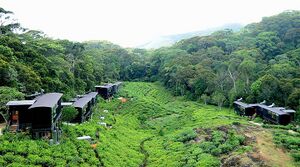
The Sri Lanka Mangrove Conservation Project
Starting in 2015, the Sri Lanka Mangrove Conservation Project[17] was an initiative by Seacology to restore and protect all of Sri Lanka's mangrove forests. Mangrove forests are found at the junction of freshwater and saltwater ecosystems in the tropics, and serve an important ecological role both locally and globally. Mangroves strengthen aquatic ecosystems by providing nursing grounds for fish, protecting them from predation, and serving as habitats for a variety of wildlife. They also play a role as green infrastructure, protecting coastal communities from tsunamis, storm surges, and typhoons more effectively than seawalls, as well as preventing coastal soil erosion. Thus, healthy mangrove ecosystems are especially important for rural fishing or farming settlements[18]. Mangroves also sequester up to 50 times more CO2 than tropical rainforests due to their high subterranean biomass. However, despite their ecological significance, mangroves are woefully under-protected. In the past 50 years alone the world has lost half of all its mangrove forests at the rate of one percent per year due to land use changes and overharvesting timber. At current rates of deforestation, all unprotected mangroves may be gone in the next 100 years[19].
To address this, the Sri Lanka Mangrove Conservation Project offered livelihood training and microloans to local women in exchange for leadership and participation in mangrove conservation cooperatives via community benefit organizations, which were established in every coastal village that lies adjacent to a mangrove lagoon. The project was successful in protecting all 8,815 hectares of Sri Lanka’s mangrove forests in around 1,500 communities, as well as replanting almost 4,000 hectares of mangrove forests that were cut down, an effort involving approximately 12,000 Lankan women. It culminated with the establishment of the Lanka Mangrove Museum, the first of its kind[20]. Overall, the project had far-reaching ecological and social benefits, from increased tourism and economic opportunities to decreased erosion and increased water quality, and set an inspiring example for the international community for mangrove conservation.
[10]References
Please use the Wikipedia reference style. Provide a citation for every sentence, statement, thought, or bit of data not your own, giving the author, year, AND page. For dictionary references for English-language terms, I strongly recommend you use the Oxford English Dictionary. You can reference foreign-language sources but please also provide translations into English in the reference list.
Note: Before writing your wiki article on the UBC Wiki, it may be helpful to review the tips in Wikipedia: Writing better articles.[21]
- ↑ 1.0 1.1 Gunatilleke, Nimal (November 2017). "Biogeography of Sri Lanka". ResearchGate. 46 – via Ceylon Journal of Science.
- ↑ 2.0 2.1 2.2 Kapferer, Bruce (1998). Legends of people, myths of state: violence, and poltiical culture in Sri Lanka and Australia. Washington: Smithsonian Institution Press. ISBN 0874745667.
- ↑ "Maps Sri Lanka". Dec 8, 2023.
- ↑ 4.0 4.1 4.2 Volk, Richard; Bandaratilake, H.M.; Vidanage, Shamen (January 2012). "Tropical Forest and Biodiversity Analysis, Sri Lanka". ResearchGate.
- ↑ 5.0 5.1 5.2 5.3 5.4 Sarathchandra, Chaya (April 2021). "An Overview of Ecosystem Service Studies in a Tropical Biodiversity Hotspot, Sri Lanka: Key Perspectives for Future Research". MDPI. 12.
- ↑ 6.0 6.1 Wikramanayake, Eric. "Sri-Lank Dry-Zone Dry Evergreen Forests".
- ↑ 7.0 7.1 7.2 Punyawardena, Ranjith (May 2021). Climate in the Dry Zones of Sri Lanka. ResearchGate. ISBN 10.13140/RG.2.2.26445.15847 Check
|isbn=value: invalid character (help). - ↑ 8.0 8.1 8.2 8.3 8.4 8.5 (PDF) http://dl.nsf.gov.lk/bitstream/handle/1/6784/JNSF-36(Special)-25.pdf?sequence=3. Retrieved 2023-12-01. Missing or empty
|title=(help) - ↑ 9.0 9.1 (PDF) https://wgbis.ces.iisc.ac.in/biodiversity/sahyadri_enews/newsletter/issue42/bibliography/A-brief-overview-of-the-Western-Ghats.PDF. Retrieved 2023-12-01. Missing or empty
|title=(help) - ↑ 10.0 10.1 10.2 10.3 10.4 10.5 10.6 "Biodiversity Conservation in Sri Lanka, A Framework for Action" (PDF). 1999: 12. Cite journal requires
|journal=(help) - ↑ Dilhani Daskon, Chandima (2004). "HUMAN IMPACTS ON RAIN FORESTS IN SRI LANKA: THE CASE OF "SINHARAJA" FOREST RESERVE" (PDF). Human landscape ecology. line feed character in
|title=at position 53 (help) - ↑ 12.0 12.1 Surasinghe, Thilina; Kariyawasam, Ravindra; Sudasinghe, Hiranya; Karunarathna, Suranjan (2019-12-19). "Challenges in Biodiversity Conservation in a Highly Modified Tropical River Basin in Sri Lanka". Water. MDPI AG. 12 (1): 26. doi:10.3390/w12010026. ISSN 2073-4441.
- ↑ 13.0 13.1 13.2 13.3 13.4 13.5 Cite error: Invalid
<ref>tag; no text was provided for refs named:8 - ↑ Athukorala, Darshana (18 January 2021). "Impacts of Urbanization on the Muthurajawela Marsh and Negombo Lagoon, Sri Lanka: Implications for Landscape Planning towards a Sustainable Urban Wetland Ecosystem". Assessing Sustainability over Space and Time: The Emerging Roles of GIScience and Remote Sensing.
- ↑ 15.0 15.1 15.2 Withanachchi, Sisira; Kopke, Soren; Withanachchi, Chandana; Pathiranage, Ruwan; Ploeger, Angelika. "Water Resource Management in Dry Zonal Paddy Cultivation in Mahaweli River Basin, Sri Lanka: An Analysis of Spatial and Temporal Climate Change Impacts and Traditional Knowledge". ProQuest. 2: 329–354.
- ↑ 16.0 16.1 16.2 Ishwaran, Natarajan; Erdelen, Walter (1990). "Conserving Sinharaja: An Experiment in Sustainable Development in Sri Lanka". Ambio. [Springer, Royal Swedish Academy of Sciences]. 19 (5): 237–244. ISSN 16547209 00447447, 16547209 Check
|issn=value (help). JSTOR 4313703. Retrieved 2023-12-01. - ↑ "Sri Lanka Mangrove Conservation Project Page".
- ↑ Sarathchandra, Chaya; Kambach, Stephan; Ariyarathna, Sameera Chathuranga; Xu, Jianchu; Harrison, Rhett D.; Wickramasinghe, Sriyani (8 February 2018). "Significance of Mangrove Biodiversity Conservation
in Fishery Production and Living Conditions of
Coastal Communities in Sri Lanka". Diversity – via MDPI. line feed character in
|title=at position 52 (help) - ↑ Sandilyan, S; Kathiresan, K (29 November 2011). "Mangrove conservation: a global perspective". Biodiversity and Conservation.
- ↑ "Sri Lanka summary".
- ↑ En.wikipedia.org. (2018). Writing better articles. [online] Available at: https://en.wikipedia.org/wiki/Wikipedia:Writing_better_articles [Accessed 18 Jan. 2018].
9. [7]
| This Tropical Ecology Resource was created by Course:GEOS303. |
- ↑ Cite error: Invalid
<ref>tag; no text was provided for refs namedAnon. h071 - ↑ Cite error: Invalid
<ref>tag; no text was provided for refs namedIshwaran Erdelen 1990 pp. 237–244 - ↑ Coalition, Global Forest; Admin, GFC (2019-05-22). "Our Biodiversity, Our Food, Our Health: community conservation in Sri Lanka". Global Forest Coalition. Retrieved 2023-12-01.
- ↑ Guardian, Sri Lanka (2021-03-22). "Deforestation in Sri Lanka". Sri Lanka Guardian. Retrieved 2023-12-01.
- ↑ Cite error: Invalid
<ref>tag; no text was provided for refs namedSurasinghe Kariyawasam Sudasinghe Karunarathna 2019 p. 26 - ↑ Cite error: Invalid
<ref>tag; no text was provided for refs namedAnon. q560 - ↑ Ministry of Forest and Environment (1999). "Biodiversity Conservation in Sri Lanka: A framework for Action" (PDF): 58. Cite journal requires
|journal=(help)
